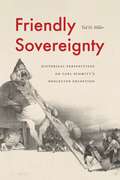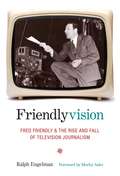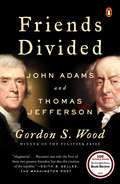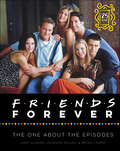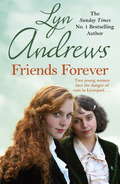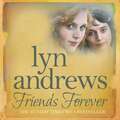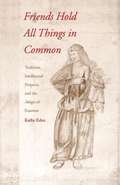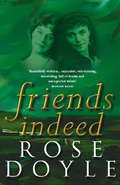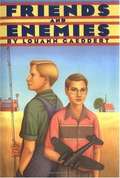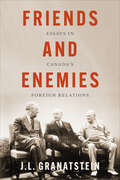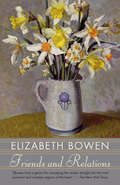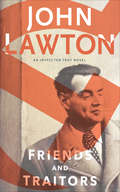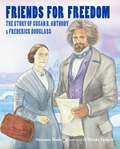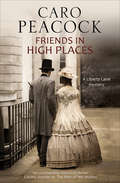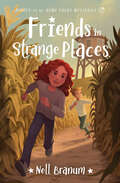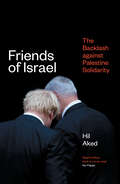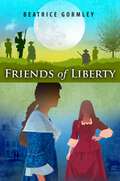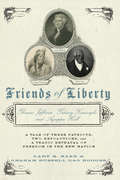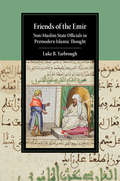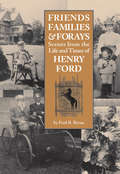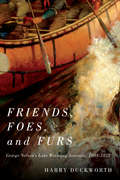- Table View
- List View
Friendly Sovereignty: Historical Perspectives on Carl Schmitt's Neglected Exception
by Ted H. MillerOver the last one hundred years, the term “sovereignty” has often been associated with the capacity of leaders to declare emergencies and to unleash harmful, extralegal force against those deemed enemies. Friendly Sovereignty explores the blind spots of this influential perspective.Ted H. Miller challenges the view of sovereignty propounded by Carl Schmitt, the Weimar and Nazi–period jurist and political theorist whose theory undergirds this understanding of sovereignty. Claiming a return to concepts of sovereignty forgotten by his liberal contemporaries, Schmitt was preoccupied with the legal exceptions required, he said, to rescue polities in crisis. Much is missing from what Schmitt harvests from the past. His framework systematically overlooks another extralegal power, one that often caused consternation, even among absolutists like Thomas Hobbes. Sovereigns also made exceptions for friends, allies, and dependents. Friendly Sovereignty plumbs the history of political thought about sovereignty to illustrate this other side of the sovereign’s exception-making power. At the core of this extensive study are three thinkers, each of whom stakes out a distinct position on the merits and demerits of a “friendly sovereign”: the nineteenth-century historian Jules Michelet, the seventeenth-century political philosopher Thomas Hobbes, and Seneca, the ancient Stoic and teacher of Nero.Analytically rigorous and thorough in its intellectual history, Friendly Sovereignty presents a more comprehensive understanding of sovereignty than the one typically taught today. It will be particularly useful to scholars and students of political theory and philosophy.
Friendlyvision: Fred Friendly and the Rise and Fall of Television Journalism
by Ralph EngelmanFred Friendly (1915-1998) was the single most important personality in news and public affairs programming during the first four decades of American television. Portrayed by George Clooney in the film Good Night and Good Luck, Friendly, together with Edward R. Murrow, invented the television documentary format and subsequently oversaw the birth of public television. Juggling the roles of producer, policy maker, and teacher, Friendly had an unprecedented impact on the development of CBS in its heyday, wielded extensive influence at the Ford Foundation under the presidency of McGeorge Bundy, and trained a generation of journalists at Columbia University during a tumultuous period of student revolt.Ralph Engelman's biography is the first comprehensive account of Friendly's life and work. Known as a "brilliant monster," Friendly stood at the center of television's unique response to McCarthyism, Watergate, and the Vietnam War, and the pitched battles he fought continue to resonate in the troubled world of television news. Engelman's fascinating psychological portrait explores the sources of Friendly's legendary rage and his extraordinary achievement. Drawing on private papers and interviews with colleagues, family members, and friends, Friendlyvision is the definitive story of broadcast journalism's infamous "wild man," providing a crucial perspective on the past and future character of American journalism.
Friends Divided: John Adams and Thomas Jefferson
by Gordon S. WoodFrom the great historian of the American Revolution, New York Times-bestselling and Pulitzer-winning Gordon Wood, comes a majestic dual biography of two of America's most enduringly fascinating figures, whose partnership helped birth a nation, and whose subsequent falling out did much to fix its course.Thomas Jefferson and John Adams could scarcely have come from more different worlds, or been more different in temperament. Jefferson, the optimist with enough faith in the innate goodness of his fellow man to be democracy's champion, was an aristocratic Southern slaveowner, while Adams, the overachiever from New England's rising middling classes, painfully aware he was no aristocrat, was a skeptic about popular rule and a defender of a more elitist view of government. They worked closely in the crucible of revolution, crafting the Declaration of Independence and leading, with Franklin, the diplomatic effort that brought France into the fight. But ultimately, their profound differences would lead to a fundamental crisis, in their friendship and in the nation writ large, as they became the figureheads of two entirely new forces, the first American political parties. It was a bitter breach, lasting through the presidential administrations of both men, and beyond. But late in life, something remarkable happened: these two men were nudged into reconciliation. What started as a grudging trickle of correspondence became a great flood, and a friendship was rekindled, over the course of hundreds of letters. In their final years they were the last surviving founding fathers and cherished their role in this mighty young republic as it approached the half century mark in 1826. At last, on the afternoon of July 4th, 50 years to the day after the signing of the Declaration, Adams let out a sigh and said, "At least Jefferson still lives." He died soon thereafter. In fact, a few hours earlier on that same day, far to the south in his home in Monticello, Jefferson died as well. Arguably no relationship in this country's history carries as much freight as that of John Adams of Massachusetts and Thomas Jefferson of Virginia. Gordon Wood has more than done justice to these entwined lives and their meaning; he has written a magnificent new addition to America's collective story.
Friends Forever: The One About the Episodes
by Gary Susman Jeannine Dillon Bryan CairnsAn authorized episode guide of the hit-television show Friends, with an insider look at cult-favorite episodes, exclusive photos, and interviews.The beloved show Friends introduced the world to six young New Yorkers living together, falling in love, breaking up, and getting into hilarious shenanigans, which became an instant classic formula that inspired dozens of “hangout sitcoms” long after the show’s reign. But no sitcom has ever come close to the series that started it all, spawning iconic looks like “the Rachel” and timeless catchphrases like “How you doin’?” while creating a cultural sensation that catapulted the cast members to instant mega-stardom.Throughout the show’s ten- season run, viewers watched Monica, Rachel, Phoebe, Ross, Chandler, and Joey navigate their twenties and thirties with unwavering friendship, determination, and, of course, plenty of sarcasm. Friends Forever takes fans back to the set where it all began with exclusive photos of the sitcom that won four Primetime Emmy Awards, including Outstanding Comedy Series, eleven People’s Choice Awards, and a Golden Globe for Jennifer Aniston for Best Lead Actress in a Television Series. This fully illustrated episode guide will treat readers to nostalgic flashbacks of the top one hundred episodes and sneak peeks of how popularly referenced lines from the show came to be. Friends Forever also boasts new interviews with show creators David Crane and Marta Kauffman on how the show got its start and set designer John Shaffner who reveals his inspirations behind the iconic looks behind Monica’s and Rachel’s apartment and Central Perk.It’s no wonder why Friends is often called one of the best sitcoms of all time.
Friends Forever: Two young Irish women must battle their way out of poverty in Liverpool
by Lyn AndrewsTwo young women find the bond of lifelong friendship gives them the strength to hold on to their dreams, in the hardship of 1920s Liverpool. In Friends Forever, Lyn Andrews weaves an unforgettable saga of friendship overcoming life's hardships. Perfect for fans of Anne Baker, Nadine Dorries and Joan Jonker.In 1928 Bernie O'Sullivan and Molly Keegan catch their first glimpse of the bustling city they're about to call home. Both seventeen, and best friends since childhood, the girls have left Ireland behind for an exciting new life in Liverpool.They are dismayed to discover that the relatives they are to stay with have barely two pennies to rub together; the promised grand house is a run-down building in one of Liverpool's worst slum areas. Desperate to escape, Bernie secures a position as a domestic servant, while Molly is taken on as a shop assistant.Soon they have settled and find themselves in love with local men. For both, though, love holds surprises and the danger of ruin in an unforgiving world... What readers are saying about Friends Forever: 'The story and characters are riveting''Lyn Andrews is an excellent writer. Good story line, interesting characters... Kept me up late but it was worth it''Five stars' Don't miss the equally moving wartime sequel, Every Mother's Son.
Friends Forever: Two young Irish women must battle their way out of poverty in Liverpool
by Lyn AndrewsTwo young women find the bond of lifelong friendship gives them the strength to hold on to their dreams, in the hardship of 1920s Liverpool. In Friends Forever, Lyn Andrews weaves an unforgettable saga of friendship overcoming life's hardships. Perfect for fans of Anne Baker, Nadine Dorries and Joan Jonker.In 1928 Bernie O'Sullivan and Molly Keegan catch their first glimpse of the bustling city they're about to call home. Both seventeen, and best friends since childhood, the girls have left Ireland behind for an exciting new life in Liverpool.They are dismayed to discover that the relatives they are to stay with have barely two pennies to rub together; the promised grand house is a run-down building in one of Liverpool's worst slum areas. Desperate to escape, Bernie secures a position as a domestic servant, while Molly is taken on as a shop assistant.Soon they have settled and find themselves in love with local men. For both, though, love holds surprises and the danger of ruin in an unforgiving world...What readers are saying about Friends Forever: 'The story and characters are riveting''Lyn Andrews is an excellent writer. Good story line, interesting characters... Kept me up late but it was worth it''Five stars'Don't miss the equally moving wartime sequel, Every Mother's Son.
Friends Forever: Two young Irish women must battle their way out of poverty in Liverpool
by Lyn AndrewsFRIENDS FOREVER is the moving saga from bestselling author Lyn Andrews. A must read for fans of Kitty Neale and Ellie Deane.In 1928 Bernie O'Sullivan and Molly Keegan catch their first glimpse of the bustling city they're about to call home. Both seventeen, and best friends since childhood, the girls have left Ireland behind for an exciting new life in Liverpool.They are dismayed to discover that the relatives they are to stay with have barely two pennies to rub together; the promised grand house is a run-down building in one of Liverpool's worst slum areas. Desperate to escape, Bernie secures a position as a domestic servant, while Molly is taken on as a shop assistant. Soon they have settled and find themselves in love with local men. For both, though, love holds surprises and the danger of ruin in an unforgiving world...
Friends Hold All Things in Common: Tradition, Intellectual Property, and the Adages of Erasmus
by Kathy EdenResponding in 1523 to a request from his friend John Botzheim, then Canon of Constance, to provide a catalogue of his works, Erasmus recalls among many other things the unfortunate events that occasioned his making a collection of Greek and Roman proverbs--the project that secured his literary fame throughout Europe and that has come down to us as the Adages.
Friends Indeed
by Rose DoyleNineteenth-century Dublin is a city riven by the greed of an emerging middle class and the unspeakable poverty of the poor. Alicia Buckley and Sarah Rooney, growing up there, embody that divide. Despite their different backgrounds, the girls enjoy an extraordinary friendship, so when Sarah falls pregnant, and is thrown out by her father, Allie doesn't think twice about joining her friend in exile. Neither woman is prepared for the deprivations she will face. Pursuing Sarah's soldier lover Jimmy Vance, they make their way, with baby James to Kildare, where they become part of a community of outcast women, known as the Wrens of the Curragh. Reviled in the local town, the women live rough, savage lives on the outskirts of the army camp. But there is also sharing and trust, through her work as the community's doctor, a liberation for Allie from the stifling expectations of her family.Tragedy, however, forces them to travel to America, but a final twist of fate means that only Alice will reach that brave new world, adopting her friend's son as her own, and eventually agreeing to marry Jimmy Vance to give the child a father.
Friends and Enemies
by Louann GaeddertOn the day William and his family move into the parsonage in Plaintown, Kansas, he meets two boys who will also be high school freshmen. Clive is immediately hostile, introducing him as "Silly Willy" and "Preacher's Brat". During the first week of school Clive knocks William to the sidewalk and punches and pounds on him until Jim interferes. Jim and William quickly become friends. They share many classes, band, and lunch. On Saturdays, they often go fishing. Late in the autumn, they camp out, and Jim demonstrates astonishing courage. But when Pearl Harbor is bombed, war divides the town and destroys William's friendship with Jim. Caught up in the mood of patriotism that sweeps the country, William is eager to do whatever he can to support the war effort. Jim, a Mennonite pacifist, won't even sing patriotic songs, much less help the war effort by collecting scrap iron and newspapers. Clive's brother is fighting in the Pacific, but Jim's brothers refuse to carry guns. Although William's father, the Methodist minister, preaches tolerance, Plaintown's "patriotic Americans" harass their Mennonite neighbors, accusing them of cowardice and of sympathy for the enemy. William finds himself alone and isolated, distanced from Jim and Jim's Mennonite friends, yet unwilling to surrender to the demands of Clive and Clive's friends. Drastic changes within William's family add to his distress. This novel about friendship and courage explores the issue of pacifism against the backdrop of World War II.
Friends and Enemies: Essays in Canada’s Foreign Relations
by J.L. GranatsteinFriends and Enemies presents a collection of essays on Canadian foreign policy written by J.L. Granatstein, one of the leading political and military historians in the country. The essays cover a period primarily from the Second World War through to the early 2000s and examine policy under prime ministers Mackenzie King, Louis St. Laurent, John Diefenbaker, Lester Pearson, and Pierre Trudeau. Based on interviews and extensive archival research, the essays reveal how Granatstein’s views shifted as he reacted to altered conditions in Canada, Canadian alliances, and the world situation.
Friends and Families
by Margaret KaineTwo girls on different sides of the class divide, living on one streetAs a child, fiery and ambitious Josie Ford sees from a distance the affluent lifestyle of young Georgina Hawkins, and is filled with envy. But Georgina is lonely, and longs to experience the warmth of working-class family life. Beneath the shadow of Georgina's domineering father, the two girls meet in secret. From this forbidden friendship grows a bond so strong nothing can break it.And then the men enter their lives. Josie falls unwillingly in love with Nick: as a market trader, surely he can't offer her the lifestyle she now craves? Georgina, an incurable romantic, falls in love with the first man she meets, but the mysterious Dominic breaks her heart.And now both girls need their friendship more than they ever have before.***********Praise for Friends and Families'The story pulls you in and doesn't let you go till the end, a sign of how much warmth this book holds'Kilkenny People'The author brings to life with great skill the emotions of young girls growing up in the 1950s. . . This is a compelling love story, set firmly in the Potteries, and Margaret Kaine moves with ease between the two different worlds. . . It's a feel-good book'Historical Novel Society
Friends and Relations: A Novel (Penguin Modern Classics Ser.)
by Elizabeth BowenElizabeth Bowen&’s deceptively simple novel opens with the weddings of two quietly conventional sisters: Laurel to Edward, and Janet to Rodney. Ten years later, one intense week is all it takes to unravel the couples&’ peaceful lives as a long-concealed secret explodes to the surface. The repercussions ripple through four different families connected by the two marriages, hinging on the comic interventions of such vivid characters as Edward&’s mother, the glamorous and scandal-ridden Lady Elfrida; Rodney&’s notorious rake of an uncle; and a stridently awkward teenager, Theodora, who is keen to insert herself into the drama. Humor and pain abound in Friends and Relations, as Bowen weaves the barest hints of menace and the subtlest nuances of emotion into this devastating tale of the tangled web of human relationships.
Friends and Traitors (The Inspector Troy Novels #8)
by John LawtonInspector Troy of Scotland Yard stars in thriller that&’s &“part murder mystery, part spy tale . . . a wickedly seductive entertainment&” (TheWashington Post). London, 1958. Chief Superintendent Frederick Troy of Scotland Yard, newly promoted after good service during Nikita Khrushchev&’s visit to Britain, is not looking forward to a European trip with his older brother, Rod. Rod has decided to take his entire family on &“the Grand Tour&” for his fifty-first birthday: a whirlwind of restaurants, galleries, and concert halls from Paris to Florence to Vienna to Amsterdam. But Frederick Troy only gets as far as Vienna. It is there that he crosses paths with an old acquaintance, a man who always seems to be followed by trouble: British-spy-turned-Soviet-agent Guy Burgess. Suffice it to say that Troy is more than surprised when Burgess, who has escaped from the bosom of Moscow for a quick visit to Vienna, tells him something extraordinary: &“I want to come home.&” Troy knows this news will cause a ruckus in London—but even Troy doesn&’t expect an MI5 man to be gunned down as a result, with Troy himself suspected of doing the deed . . . &“An artful blend of two ever-popular subjects: espionage and British police work.&” —The Seattle Times &“The surprises keep coming, not merely up to the last chapter but even to the novel&’s very last line.&” —Pittsburgh Post-Gazette &“Lawton&’s superb eighth Inspector Troy novel . . . [a] smart, fascinating historical thriller.&” —Publishers Weekly (starred review) &“A beguiling interpretation of [Guy] Burgess&’ life both before and after his defection in 1951.&” —Booklist (starred review)
Friends for Freedom: The Story of Susan B. Anthony & Frederick Douglass
by Suzanne SladeTheir friendship changed a nation.No one thought Susan B. Anthony and Frederick Douglass would ever become friends. The former slave and the outspoken woman came from two different worlds. But they shared deep-seated beliefs in equality and the need to fight for it. Despite naysayers, hecklers, arsonists, and even their own disagreements, Susan and Frederick remained fast friends and worked together to change America. This little-known story introduces young readers to two momentous personalities in American history and to their fiery passion for human rights and equality.
Friends in High Places: A Victorian London Mystery (A Liberty Lane Mystery #7)
by Caro Peacock&“A pleasurable read. The Victorian setting and international political intrigue, together with the murder mystery, add complexity to the plot.&” —Historical Novel Society September, 1840. Novelist and patron of the arts Lady Blessington has hired private investigator Liberty Lane to escort a French gentleman to The Hague. For he has in his possession important papers that will assist in the forthcoming trial of Prince Louis Napoleon Bonaparte, the late emperor&’s nephew who has failed in an attempt to seize power in France. Plans for the undercover expedition are disrupted however when a body is found hanging in the attic at Gore House, Lady Blessington&’s Kensington mansion. Uncovering evidence that the murder was meticulously prepared for and planned well in advance, Liberty determines to track down the killer. But she is about to find herself plunged into a highly dangerous game involving blackmail, treachery, espionage—and cold-blooded murder. &“A crackerjack plot and engaging characters make Peacock&’s seventh Liberty Lane mystery her best yet.&” —Publishers Weekly &“Liberty is a strong character who draws her cases from high society but can work the underbelly to track down the information she needs.&” —Booklist
Friends in Strange Places: Heroes on the Home Front Mysteries #2 (Heroes on the Home Front Mysteries)
by Nell BranumEvery dog needs a good home. And Riley and Noah are on a road trip with Grandma Suzie to meet a fluff ball perfect for their grandma. But when they visit and fall in love with the adorable pooch, will their hopes get unexpectedly dashed? What&’s more, the kids&’ quest for a canine companion takes a turn when they make a discovery. The town they&’re visiting once included a camp for prisoners of war . . . and it&’s gearing up for a reunion. Army guards, former German prisoners, and townsfolk together again? Maybe that&’s not such a good idea. When suspicion and sabotage begin to take place, the kids, along with a new friend, are on the case. But after they track one suspect into a corn maze, they realize the danger is as high as the corn stalks. Will the friends make it out in time to confirm their suspicions? What began as the best road trip ever is quickly becoming an adventure in trusting God through disappointment and danger—and the kids just might find a surprise ending after all.
Friends of Freedom: The Rise of Social Movements in the Age of Atlantic Revolutions
by Micah AlpaughFrom the Sons of Liberty to British reformers, Irish patriots, French Jacobins, Haitian revolutionaries and American Democrats, the greatest social movements of the Age of Atlantic Revolutions grew as part of a common, interrelated pattern. In this new transnational history, Micah Alpaugh demonstrates the connections between the most prominent causes of the era, as they drew upon each other's models to seek unprecedented changes in government. As Friends of Freedom, activists shared ideas and strategies internationally, creating a chain of broad-based campaigns that mobilized the American Revolution, British Parliamentary Reform, Irish nationalism, movements for religious freedom, abolitionism, the French Revolution, the Haitian Revolution, and American party politics. Rather than a series of distinct national histories, Alpaugh shows how these movements jointly responded to the Atlantic trends of their era to create a new way to alter or overthrow governments: mobilizing massive social movements.
Friends of Israel: The Backlash Against Palestine Solidarity
by Hilary Frances AkedIs there such a thing as &“the Israel lobby,&” and how powerful is it really? Friends of Israel provides a forensically researched account of the activities of Israel&’s advocates in Britain, showing how they contribute to maintaining Israeli apartheid. The book traces the history and changing fortunes of key actors within the British Zionist movement in the context of the Israeli government&’s contemporary efforts to repress a rising tide of solidarity with Palestinians expressed through the Boycott Divestment and Sanctions (BDS) movement. Offering a nuanced and politically relevant account of pro-Israel actors&’ strategies, tactics, and varying levels of success in key arenas of society, it draws parallels with the similar anti-boycott campaign waged by supporters of the erstwhile apartheid regime in South Africa. By demystifying the actors involved in the Zionist movement, the book provides an anti-racist analysis of the pro-Israel lobby which robustly rebuffs anti-Semitic conspiracies. Sensitively and accessibly written, it emphasises the complicity of British actors - both those in government and in civil society. Drawing on a range of sources including interviews with leading pro-Israel activists and Palestinian rights activists, documents obtained through Freedom of Information requests and archival material, Friends of Israel is a much-needed contribution to Israel/Palestine-related scholarship and a useful resource for the Palestine solidarity movement.
Friends of Liberty
by Beatrice GormleyIt's 1773, and Boston is in political turmoil. As tension rises between England and the colonies, lines are being drawn between the Loyalists and the Patriots. And Sally Gifford, a shoemaker's daughter, finds herself on the opposite side from her best friend Kitty Lawton, the daughter of a wealthy merchant.Sally is torn between her cherished friendship and her loyalties to her own family and community in their fight for freedom. As the conflict continues to grow more charged in the weeks leading up to the Boston Tea Party, Sally finds within herself a bravery she didn't know she had, and ultimately takes a stand for what she comes to find is most important.
Friends of Liberty: A Tale of Three Patriots, Two Revolutions, and a Tragic Betrayal of Freedom in the New Nation
by Gary B. Nash Graham Russell Gao HodgesFriends of Liberty tells the remarkable story of three men whose lives were braided together by issues of liberty and race that fueled revolutions across two continents. Thomas Jefferson wrote the founding documents of the United States. Thaddeus Kosciuszko was a hero of the American Revolution and later led a spectacular but failed uprising in Poland, his homeland. Agrippa Hull, a freeborn black New Englander, volunteered at eighteen to join the Continental Army. During the Revolution, Hull served Kosciuszko as an orderly, and the two became fast friends. Kosciuszko’s abhorrence of bondage shaped histhinking about the oppression in his own land. When Kosciuszko returned to America in the 1790s, bearing the wounds of his own failed revolution, he and Jefferson forged an intense friendship based on their shared dreams for the global expansion of human freedom. They sealed their bond with a blood compact whereby Jefferson would liberate his slaves upon Kosciuszko’s death. But Jefferson died without fulfilling the promise he had made to Kosciuszko-and to a fledgling nation founded on the principle of liberty and justice for all.
Friends of the Emir: Non-Muslim State Officials in Premodern Islamic Thought (Cambridge Studies in Islamic Civilization)
by Luke B. YarbroughThe caliphs and sultans who once ruled the Muslim world were often assisted by powerful Jewish, Christian, Zoroastrian and other non-Muslim state officials, whose employment occasioned energetic discussions among Muslim scholars and rulers. This book reveals those discussions for the first time in all their diversity, drawing on unexplored medieval sources in the realms of law, history, poetry, entertaining literature, administration, and polemic. It follows the discourse on non-Muslim officials from its beginnings in the Umayyad empire (661–750), through medieval Iraq, Egypt, Syria, and Spain, to its apex in the Mamluk period (1250–1517). Far from being an intrinsic part of Islam, views about non-Muslim state officials were devised, transmitted, and elaborated at moments of intense competition between Muslim and non-Muslim learned elites. At other times, Muslim rulers employed non-Muslims without eliciting opposition. The particular shape of the Islamic discourse is comparable to analogous discourses in medieval Europe and China.
Friends, Families & Forays: Scenes from the Life and Times of Henry Ford
by Ford R. BryanAn illustrated collection of essays about the various people, events, and experiments from Henry Ford's lifetime.
Friends, Foes, and Furs: George Nelson's Lake Winnipeg Journals, 1804–1822 (Rupert's Land Record Society Series #15)
by Harry W. DuckworthGeorge Nelson (1786–1859) was a clerk for the North West Company whose unusually detailed and personal writings provide a compelling portrait of the people engaged in the golden age of the Canadian fur trade. Friends, Foes, and Furs is a critical edition of Nelson's daily journals, supplemented with exciting anecdotes from his "Reminiscences," which were written after his retirement to Lower Canada. An introduction and annotations by Harry Duckworth place Nelson's material securely within the established body of fur trade history. This series of journals gives readers a first-person account of Nelson's life and career, from his arrival at the age of eighteen in Lake Winnipeg, where he was stationed as an apprentice clerk from 1804 to 1813, to his second service from 1818 to 1819 and an 1822 canoe journey through the region. A keen and respectful observer, Nelson recorded in his daily journals not only the minutiae of his work, but also details about the lives of voyageurs, the Ojibwe and Swampy Cree communities, and others involved in the fur trade. His insights uncover an extraordinary view of the Lake Winnipeg region in the period just prior to European settlement. Making the full extent of George Nelson's journals available for the first time, Friends, Foes, and Furs is an intriguing account of one man's adventures in the fur trade in prairie Canada.
Friends, Foes, and Furs: George Nelson's Lake Winnipeg Journals, 1804–1822 (Rupert's Land Record Society Series #15)
by Harry W. DuckworthGeorge Nelson (1786-1859) was a clerk for the North West Company whose unusually detailed and personal writings provide a compelling portrait of the people engaged in the golden age of the Canadian fur trade. Friends, Foes, and Furs is a critical edition of Nelson's daily journals, supplemented with exciting anecdotes from his "Reminiscences," which were written after his retirement to Lower Canada. An introduction and annotations by Harry Duckworth place Nelson's material securely within the established body of fur trade history. This series of journals gives readers a first-person account of Nelson's life and career, from his arrival at the age of eighteen in Lake Winnipeg, where he was stationed as an apprentice clerk from 1804 to 1813, to his second service from 1818 to 1819 and an 1822 canoe journey through the region. A keen and respectful observer, Nelson recorded in his daily journals not only the minutiae of his work, but also details about the lives of voyageurs, the Ojibwe and Swampy Cree communities, and others involved in the fur trade. His insights uncover an extraordinary view of the Lake Winnipeg region in the period just prior to European settlement. Making the full extent of George Nelson's journals available for the first time, Friends, Foes, and Furs is an intriguing account of one man's adventures in the fur trade in prairie Canada.
